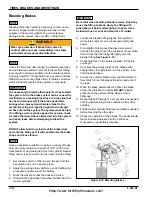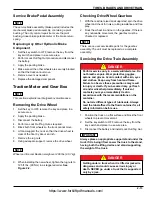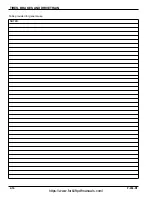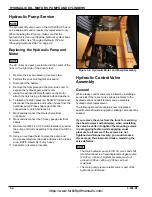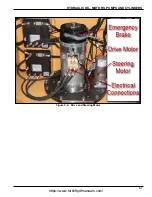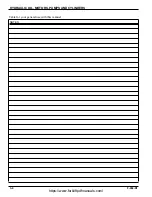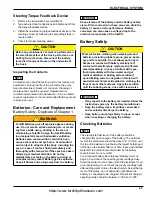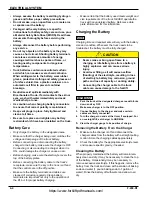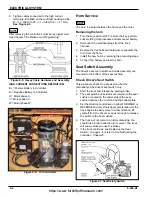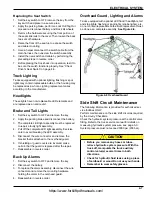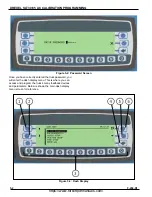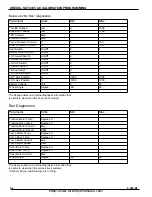
HYDRAULIC OIL, MOTORS, PUMPS AND CYLINDERS
3-5
NOTE
• A pressure gauge port is provided, with a
“quick-coupler” (pressure service kit, Landoll p.n.
0018152), for reading the pump pressure on the
hydraulic control valve. The pressure check port on
the forklift is attached to the inlet port on the hydraulic
control valve.
IMPORTANT
• Before you service this valve for possible pressure
problems, make sure there are no leaks in the
hydraulic system and that there is sufficient oil in the
tank. Both conditions can contribute to low pressure
problems.
Mast Service Precautions
WARNING
• Mast work to be done in a flat, designated area.
• NEVER walk under or stand upon forklift forks.
• Remove forks before starting mast repairs.
• NEVER reach through the upright open areas of
the mast.
• NEVER maintain or repair the mast without
supports or while anyone is near the truck.
(ASME B56.1-2000)
• Raise mast and position blocks under the second
stage mast.
• Using an appropriate set of C-clamps, secure
wooden blocks to mast channel.
• Lower mast until it sits firmly on wooden blocks.
• Disable the truck as described in the Lock
Out/Tag Out section, page 1-3.
• For mast inspection, use only an approved safety
platform or step ladder.
• NEVER repair chains, they are to be replaced.
• NEVER replace only one chain. All chains are to
be replaced in pairs.
Disconnecting the Tilt Cylinder
WARNING
• Truck repair must be in a level, designated area.
• Turn the lift off and remove the key.
• Lower the mast completely to the floor.
• Chock wheels so that the truck cannot move.
• Attach a sling and hoist to all the top
cross-members of the mast so the mast sections
cannot move.
Mast Removal Precautions
1.
Move the truck to a level, designated area.
2.
Remove the key and place it in a secure place.
3.
Perform the Lock Out/Tag Out procedure.
4.
Remove the battery.
5.
Remove the forks.
6.
Slowly and carefully remove the lift cylinder lines.
Use a container to catch oil and an oil absorbent
product to absorb any spills.
7.
Disconnect all wiring (if used) between the mast and
the truck body.
8.
Support the mast using the sling and the overhead
hoist.
9.
Chain the individual sections of mast together at the
upper cross braces. Chain the lower mast carriage to
the lower section of the mast, keeping the sections
from moving when the mast is laid down on the floor.
10. Remove all pins holding the tilt cylinders to the mast.
11. Unscrew the four bolts clamping the mast trunnions
to the truck.
12. Remove mast and CAREFULLY place the mast in a
horizontal position.
When servicing the mast or sections of the mast,
hardwood blocks (4”X4”, 100 X 100mm minimum)
should be used to keep individual sections of the
mast from falling. In addition to the wood blocks,
chains should be used to hold the mast sections
from moving, in both the vertical and horizontal
directions.
• Steel toed shoes and eye protection are
required when doing maintenance or repair
work on a lift truck.
• Do not place feet or hands in any areas
through the mast or in truck pinch points.
• Servicing the tilt cylinders requires the use of
an overhead hoist, hoist slings and wheel
blocks. The overhead hoist and slings must
have a rating of 8,000 lb. or greater.
• Do not work under or around a truck that is
not properly secured. The battery must be
disconnected and removed from the truck.
https://www.forkliftpdfmanuals.com/






